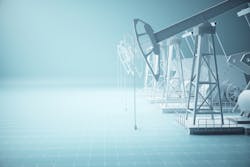Intelligent Artificial Lift Systems Improve Digital Oilfield Operations
Oil and gas producers have been feeling the pressure in this down market to get the most from their existing assets and wellheads, as efficiently and cost effectively as possible.
Fortunately, new technologies and capabilities available in the digital oilfield provide a means to do just that. A combination of low-cost sensors, intelligent assets and information tools allow oil and gas producers gather more data, and have better control of their artificial lift systems.
These intelligent artificial lift systems can help producers realize three primary business benefits in their wellhead applications:
- Better visibility into operations
- Optimized production and asset performance
- Reduced operating costs
Gain Better Visibility
Large, multinational oil and gas producers often use downhole sensor systems to monitor underground pressure and temperature. However, many mid- and small-size producers don’t have the luxury of using these systems, which have high upfront costs and long-term maintenance requirements.
When downhole sensor systems aren’t an option, virtual flowmeters (VFM) provide an economical alternative for understanding underground conditions. VFMs calculate the three-phase flow of water, oil and gas at the wellhead, and provide well analysis for performance improvement. They can calculate the data at either the wellhead site or at the control-system level.
VFMs do require some upfront calibration, but that’s a small price to pay considering they’re a fraction of the cost of downhole sensors and can produce data of similar accuracy. In fact, one lab test we conducted for a major oil producer found the VFMs delivered more than 90 percent data accuracy compared to actual well-test data.
Another attractive aspect of VFMs is their scalability. This means they can be deployed across multiple lift methods, from highly productive multi-well pads to low-producing wells.
Optimize Production
For all the value that VFMs offer, they’re only truly valuable if a producer can put the data produced to good use. Once an oil and gas producer collects VFM data, they must be able to analyze and act on it to improve their operations.
Some oil and gas producers choose to contract out these data-collection and analysis activities to an outside service provider. Many producers, however, prefer to manage their data in-house using business-intelligence and analytics software.
Business-intelligence software integrates data not only from VFMs, but also from all other inputs across an oilfield. This creates a single information-management and decision-support system that can support all aspects of production. Analytics software provides the means to turn raw data that has been collected into production intelligence.
With these software tools in place, oil and gas producers can tap into the power of their data to optimize their operations. For example, VFM data can:
- Provide insights into underground conditions, which can be used to drive decisions about reducing bottom-hole pressure or keeping it constant
- Be compared against well-test data. This can help verify well-test data, as well as validate planning and production allocation. What’s more, users can improve utilization of test separators by refining and prioritizing test schedules for each well.
- Identify underperforming wells. Once such wells are identified, operators can then quickly take any necessary corrective actions to limit production interruptions and deferments, and ultimately stay on track with their production targets.
- Collect information on system components from different vendors over time. This data can be used to better predict when components, such as a rod, might break. And it can improve equipment and supply logistics for maintenance, helping companies be more proactive in getting ahead of downtime issues.
Reduce Operating Costs
Intelligent artificial lift systems can help bring down production costs in multiple ways. For example, energy consumption is often overlooked in oil and gas production, which is surprising given that it’s a significant operational expense.
Advanced artificial lifts primarily run on electricity, and intelligent systems can collect and analyze this energy-usage data to help companies monitor their consumption. The artificial lifts also can be equipped with drives that can regenerate power and put power back on the grid, or they can use solar power to reduce electrical usage.
Variable speed control provides another opportunity for cost savings.
Traditional lift systems have no speed control. As a result, companies either run the systems until they break or turn the systems off, which can result in sand settling into and plugging the bottom-hole equipment. Either way, oil and gas producers ultimately end up paying for these approaches in the form of costly repairs and unexpected production downtime. Modern artificial lift systems, however, can use variable speed control to help prevent plugging and maximize production efficiency.
Finally, intelligent artificial lift systems deliver improved insights into operations, which can help companies better manage their capital expenditures. For example, a company considering work over at the well can use well data to determine if the future potential yield of a reservoir justifies use of alternative methods to enhance recovery.
Breaking the Cost Barrier
Monitoring downhole conditions and equipment performance in artificial lift systems is no longer a cost-prohibitive effort. The digital oilfield is bringing these insights to more oil and gas producers at a low cost with smart and connected artificial lift systems that can help monitor wellhead applications, optimize production, reduce equipment issues and bring down production costs.
